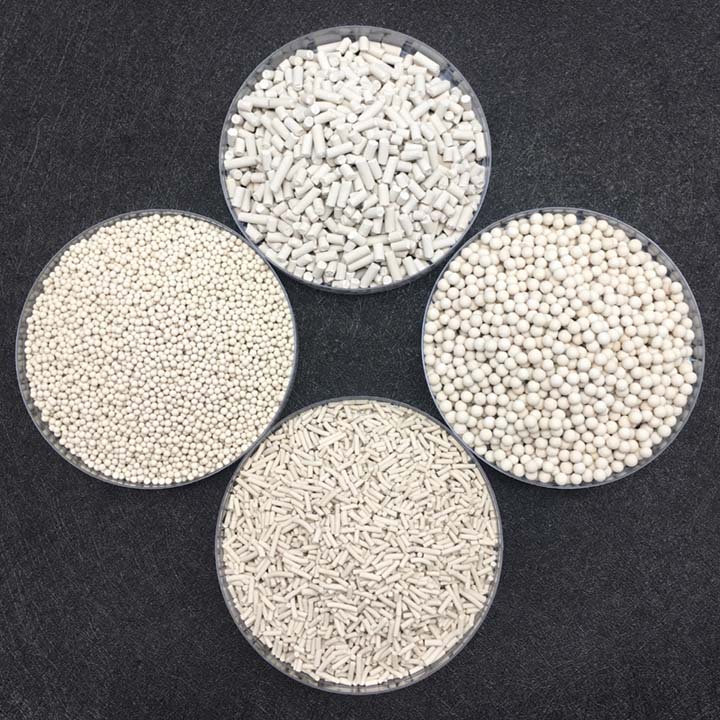Technical article
2022-03-22
Molecular sieve is a synthetic alumino silicate with a microporous cubic lattice. Molecules of different substances are adsorbed or repelled according to the size of the pores inside the crystal, so they are called "molecular sieves". Molecular sieves have metal cations (such as Na+, K+, Ca2+, Li+, etc.) in the crystal lattice to balance the excess negative charge in the crystal. The types of molecular sieves are mainly divided into: A type, X type, Y type and so on according to their crystal structure.
The properties of 4A molecular sieve are as follows:
1. Ion exchange performance----softening water quality function: Each oxygen atom in the 4A molecular sieve framework is shared by two adjacent tetrahedra, and this structure forms a large crystal cavity that can be occupied by cations and water molecules , and these cations and water molecules have greater mobility and can perform cation exchange and reversible dehydration. The ion exchange of 4A molecular sieve is carried out on the framework with aluminum ions, and each aluminum ion carries a negative charge, which can not only bind sodium ions, but also bind other cations. Calcium and magnesium ions can enter the large crystal cavity occupied by the original sodium ions, and replace the sodium ions in the 4A molecular sieve—that is, the sodium ions in the 4A molecular sieve can be ion-exchanged, and can be exchanged with Ca2+, Mg2+ ions in hard water exchange, so as to achieve the purpose of softening the water quality. The speed of 4A molecular sieve binding calcium and magnesium ions is slower than that of sodium tripolyphosphate, and the binding ability with magnesium ions is weaker. However, 4A molecular sieve can easily and quickly remove a small amount of harmful heavy metal ions (such as Pb2+, Cd2+, Hg2+) in aqueous solution, which is of great significance for purifying water quality.
2. Adsorptive to surfactant ---- carrier liquid function: Because of the pore structure of 4A molecular sieve crystal and the large specific surface area of particles, 4A molecular sieve has strong adsorption performance.
The adsorption of non-ionic surfactants, 4A molecular sieve is 3 times that of NTA (nitrilotriacetate) and sodium carbonate, and 5 times that of sodium tripolyphosphate (STPP) and sodium sulfate. It makes sense to mix more surfactants in the production of high-concentration laundry detergents to produce products with good washing and flow properties. Through experiments, the liquid carrying capacity of 4A molecular sieve is greater than or equal to 30%. Adding 4A molecular sieve in the production process of washing powder can increase the fluidity of the material, adjust the viscosity, and obtain a product with good appearance, fluidity and anti-caking ability.
3. Detergency: Through experiments, the detergency of the same formula with different additives was compared, and the detergency of the additives was changed. It was found that the decontamination effect of 20% STPP, 20% molecular sieve, and 4% polymer was equivalent to 40% STPP. , adding 10% sodium carbonate and 4 or 5% polymer to 20% molecular sieve in the phosphorus-free formula, a product with ideal detergency can be obtained.
4. Anti-redeposition: 4A molecular sieve has good adhesion to oil stains. When zeolite is added to additives such as sodium carbonate, CMC, sodium silicate and sodium sulfate, the adsorption of oil stains by nylon cloth is significantly reduced. When the particle size of zeolite is 0, 4-1, 0 μm, its dispersibility is relatively good, which can prevent adhesion on the fabric.
Although the dispersing ability of 4A molecular sieve is not as good as that of STPP, it can solve the problem of dispersing dirt by compounding with sodium polyacrylate.
5. Compatibility with other auxiliaries: 4A molecular sieve and other auxiliaries can make their performance complementary. The dispersibility of 4A molecular sieve to dirt and the chelation of hardness ions are not as good as STPP, but 4A molecular sieve is mixed with STPP to decontaminate The force can achieve the effect of single use of STPP. This is because STPP can rapidly complex calcium and magnesium ions from the solid surface and transfer them to the 4A molecular sieve through the aqueous medium. The poor ability of 4A molecular sieve to bind magnesium ions can be compensated by compounding silicate and carbonate in the molecular sieve.
